#dungeon design
Explore tagged Tumblr posts
Text
Honestly thanks for talking about your early mistakes. As a new dungeon owner it makes me much more comfortable taking risks and failing forward.
I WILL make the upside-down Dungeon-where everything is glued-to-the-ceiling-and-when-adventurers-try-to-climb-up-there-to-enter-the-fake-reverse-gravity-zone-they-just-get-stuck-upsidedown-in-the-glue-trap dungeon.
Found one of my earliest dungeons I ever made and it’s so cringe. Tried doing a 5-chamber with the 4 cardinal direction representing 4 contrasting elements, but my contrasting elements were dry for north, wet for south, soft for west, and hard for east. I Used to be such a try hard back in the day.
The dungeon sucked anyways, adventurers would just go to the soft room and easily slay the pillow mimics and then nap.
34 notes
·
View notes
Text
Dungeons
Dungeon Meshi Dungeons have unique characteristics and the Adventurer's Bible gives us a look on a few of the more important ones.
First, what makes a dungeon a dungeon? According to the Glossary section:
Dungeon There are two types of dungeon: manmade and natural. Manmade dungeons like the one on the Island are structures created when a door is linked to another dimension. Natural dungeons are environments that resemble manmade dungeons; they're created when a portal to another dimension forms on its own and mana seeps in. In natural dungeons, you can't be resurrected if you die. The cavern Falin took Marcille to when they were at magic school was a natural dungeon.
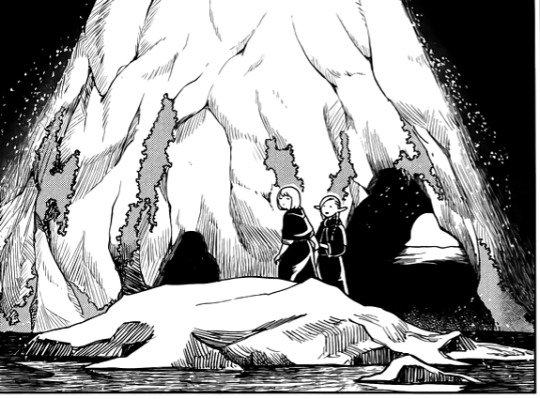
Continuing bellow the cut, Major Spoilers ahead
In ch87 we learn that man-made Dungeons were created by the ancient civilizations to contain the Demon's powers, and be able to better use it.
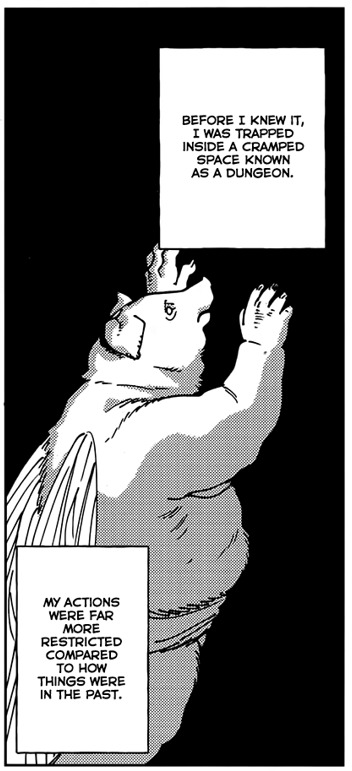
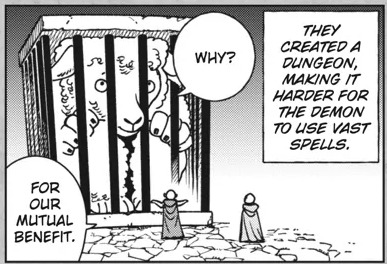
In ch 68 Thistle confirms something similar.

With this in mind, Dungeons also seem to have "Styles".
Like these examples from the cover of ch 48.
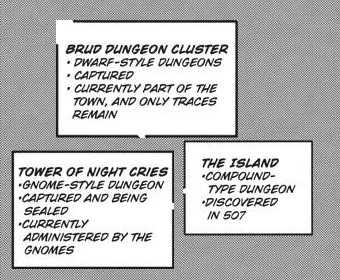
"The island", which is the name given to the Dungeon Linked to Melini Village's Graveyard, is a "Compound-Style Dungeon" while other dungeons seem to have specific styles linked to other ancient civilizations (Dwarf-Style, Gnome-Style, Elf-Style)
'The Island' in specific seem to be a Compound Style between dwarfish and elvish styles. As Thistle says, continuing in ch 68, it was an ancient Dwarf construction that was then used by Elves.
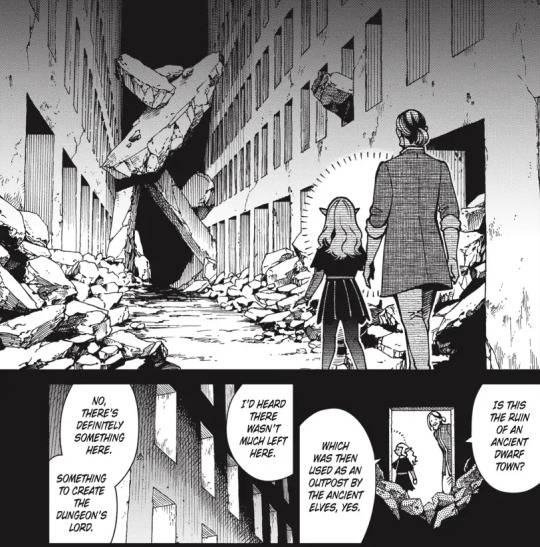
Maybe that's the reason the dwarfish inscriptions are only in the innermost levels of the dungeon. The Style then seems to indicate which ancient civilizations created the manmade Dungeon.
From how they speak about Dungeons in the story I also believe there isn't a way to create new manmade dungeons, and rather they must find them since they were buried by ancient civilizations once they realized it was impossible to control the Demon.
Besides that dungeons apparently also seem to have a life cycle, or "Maturity Levels", that ends with the collapse of the dungeon. Here's the cover for ch 54 illustrating it.
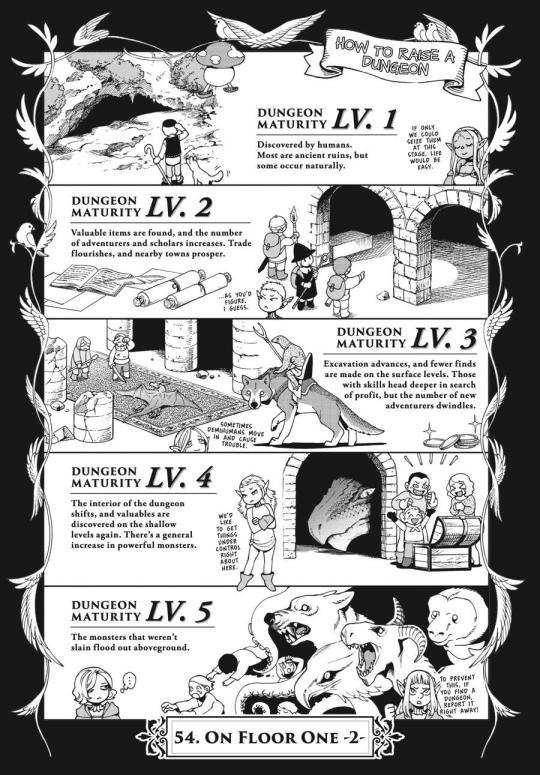
From the descriptions, Utaya seems to have reached lv 5 while others tend to be conquered and collapsed before. Some even seem to collapse on their own.
These are the main Dungeons pointed out in the adventurer's bible with their respective descriptions.
DUNGEONS
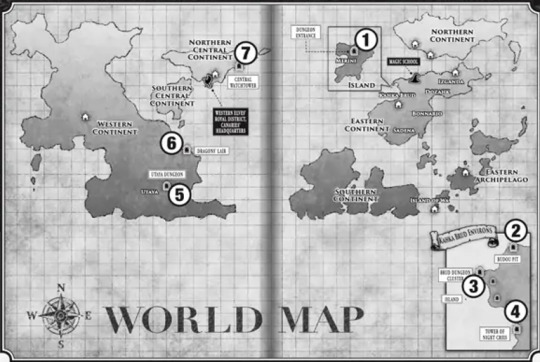
1 THE ISLAND
A new dungeon that was discovered just six years ago. It's rumored that the Golden Country that existed a thousand years ago still lies in its depths, imprisoned there by the Lunatic Magician.
2 BUDOU PIT
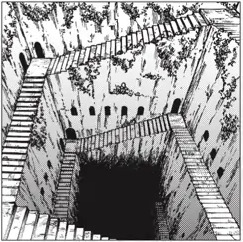
A dwarf-style dungeon. It was excavated straight down like a mine shaft and has already collapsed. Its atmosphere and location are bad, and even after it was discovered, not many adventurers visited it. As a result, it's believed to have collapsed naturally. Its depths may be connected to the ocean: If you listen carefully, some say you can hear the waves. People also claim that if you throw something into the pit, it will inevitably wash up in the port of Kahka Brud.
3 THE BRUD DUNGEON CLUSTER
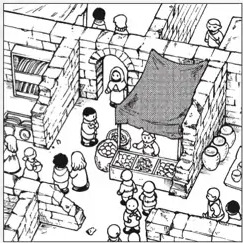
A dwarf-style dungeon. It's made of the ruins of dungeons that riddled the ground beneath Kahka Brud. Now that its last lord has been defeated, the dungeon has been completely captured. It's become part of the town, and bits of it are used as storehouses, shops, and private homes.
4 THE TOWER OF NIGHT CRIES
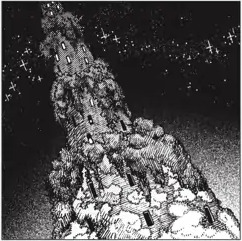
A gnome-style dungeon. It's on the verge of collapsing and is currently sealed. Since it's still functioning, if barely, it's believed to have a lord somewhere. The dungeon is shaped like a tower. Its name comes from the wailing noise produced by the wind blowing through holes in its walls at night. Winged monsters have been sighted flying around the tower.
5 THE UTAYA DUNGEON
An elf-style dungeon. It changed lords frequently, and it's the dungeon that grew the largest after the ancient war. At present, it's sealed. Fifteen years ago, monsters flooded out and destroyed the nearby towns. Because it had expanded so much, it couldn't be blocked off completely, and the Canaries quelled the situation by casting a barrier over the dungeon and the entire surrounding area. Magic users are still permanently stationed there to maintain the barrier.
6 THE DRAGONS' LAIR
An elf-style dungeon. Currently collapsed. A rare case in which an entire region of interlacing canyons became a dungeon. Many dragons lived here once, and it was a notoriously secluded region. However, it was hard just to get to it, the rewards were small, and the dragons were tough. Almost no adventurers visited it, and it's thought to have collapsed naturally. When the population dwindled, mana stopped flowing through it, so the large dragons vanished. However, a few small dragons still live there.
7 THE CENTRAL WATCHTOWER
An elf-style dungeon near the capital of the Western Elves. Currently sealed. Since it hadn't had a lord for a long time, it was believed to be nearly collapsed. Mithrun was dispatched to investigate a nearby rash of disappearances and got taken in.
There's much more to talk about how the dungeons work, especially how it relates to Ancient Magic but I'll leave it for another post in the future. If you have any insights about the information here or if I've missed something important please share!
#Dungeon Meshi#Dungeon Meshi Spoilers#Dungeons#Dungeon Design#The Island#thistle dungeon meshi#dunmeshi thoughts#Its hard to know whats relevant to the dungeons and whats more relevant for ancient magic since they're so linked#I'll try to edit the image ids and make them better later I hope these are ok
797 notes
·
View notes
Text


this is what I have so far of my one-room-a-day megadungeon project The Ziggurat of Sorrow, which I started on March 1st. So far it has 82 rooms drawn and keyed, with the final goal being 365 rooms after a full year. On the right is a sketch of the external structure superimposed on the internal layout :p
A lot of details like doors and internal room structures aren't shown here bc I'm mainly drawing it on a notebook, this digital version is just a rough sketch I use to be able to visualize the whole thing and keep the layout straight since on my notebook I have to split it into several pages.
436 notes
·
View notes
Text
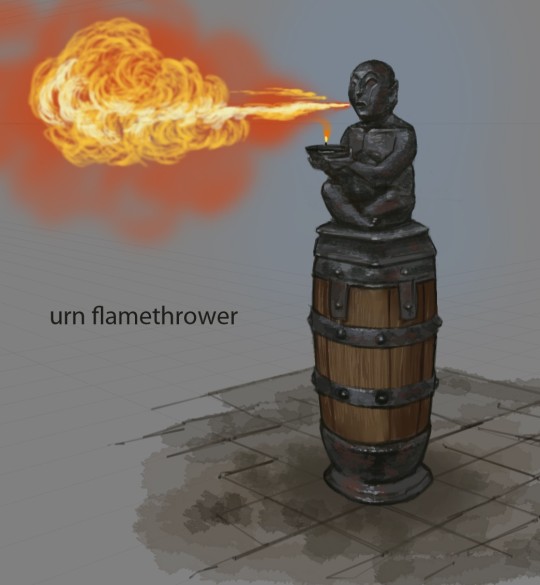
Urn Flamethrower
Concept art for The Elder Scrolls V: Skyrim
Art by Adam Adamowicz
#adam adamowicz#art#the elder scrolls#concept art#tes#skyrim#nord#flamethrower#dungeon trap#dungeon#dungeon design#trap design
239 notes
·
View notes
Text

Dungeon art by Hirotsugu Kaga in homage to Russ Nicholson
329 notes
·
View notes
Photo
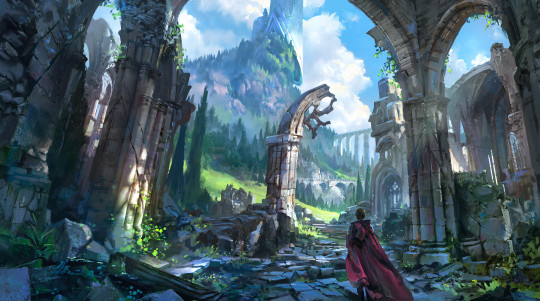
Drafting the Adventure: Dungeons Without Walls
I love the idea of dungeons, but there was a significant portion of my life as a DM where they didn’t feature in my games. While Pathfinder and 5e provided a great framework for character building and tactical skirmishes that I could build story on top of, neither was really great when it came time to detour into a dungeon. My players tended to get confused when we headed out to plunder the local ruin or cave system, spending a lot more time figuring out where they were and what they should be doing than actually doing anything.
The problem as it turned out was limited information. I had a picture of the dungeon in my head/notes but I couldn’t telepathically infer that to the party, and the back and forth questions where they tried to orient themselves within my mental labyrinth ate up a lot of session time prevented us from attaining that snappy pace that every table needs to keep the players invested.
Recently though I had an epiphany about overhauling exploration in d&d, and wrote up a whole post detailing how you could build and run wilderness adventures the same way you could a heist or a murder mystery. Because I was already writing a series about dungeon design it didn’t take long for me to realize that this exploration overhaul was 100% applicable, and could solve a lot of the delay and confusion my players usually faced on their next trip underground. Spoilers: it worked amazingly.
The key to this overhaul was giving my players enough information to see the dungeon as a sort of abstract checklist, and then giving them the power to investigate and check things off that list in whatever order they wished, when they enter a new level of the dungeon they get a new checklist to fill out which still keeps that sense of exploration. Folk love checking things off lists, and I as a dungeonmaster love it when players engage with the content I’ve spent so much energy creating even if it’s only poking their head in the door to realize they want to run away as fast as possible. Likewise, designing the dungeon this way let me tackle much larger concepts without having to sweat the details of filling up every little room as I would have to in map-centric design.
To summarize my exploration mechanic as It applies to dungeons:
During Design: After you’ve got the dungeons’ major concept, you divide it into unique “zones” (essentially what might be levels in a regular dungeon) with an interconnected theme, mechanic, or threat.
Each zone has a number of points of interest, which can be anything from trails to follow, odd sights they might investigate, to full complexes of rooms that you’ve mapped out. You don’t need to map out the points of interest otherwise, they sort of float abstractly within the zone
When players enter a zone, they become aware of its name and general descriptor, as well as how many total points of interest are in that zone. They also become aware of some points of interest immediately to serve as landmarks and give them a direction for their exploration, but most remain undiscovered until they venture off the path and start checking out their surroundings. Hidden among these points of interest are the doors that lead to zones deeper within the dungeon, encouraging the party to explore in order to progress.
During Play: When the players enter the dungeon, one player is appointed as the surveyor, who’s job it is to keep track of the zones, fill out that checklist, and check things off when the DM tells them that they’ve fully explored a point of interest.
Rather than needing to be aware of the exact room layout, the party just need to know what zone they’re in and what options are available to them, Because this information is delivered in the form of a checklist with empty spaces, the party know exactly how much of the dungeon they’ve explored, what’s left to explore, and when they’ve cleared out an area.
Lets take the image above as inspiration. Say the party is trying to make it up to the tower, you can easily see a progression of zones and maybe imagine a few to go alongside them:
Ruins & Foothills: The first area, filled with the remnants of an ancient civilization. Picked over by looters and now a home to all sorts of wildlife,
Mountainside: The obvious next goal, but locked off behind a challenging climb, Filled with hazards that threaten to knock the party back down to the foothills if they’re not careful
Caverns: Secret area accessible only if the party explore a cave on the mountainside, or make a beeline towards the old aqueduct landmark in the foothills, realizing it might be easier than the climb.
Spire Foundations: The door connecting to the foothills is guarded by a complex puzzle and arcane ward, but the party might be able to sneak in through the caves where erosion has caused a breakthrough into the cellars.
Spire Peak: High among the clouds, the party’s prize is somewhere here. Access to the upper sections of the tower are guarded by a territorial sphinx under arcane compulsion, though the party might just be able to skip that fight if they figure out the riddle to make the portal mirrors work in the foundations.
Trying to design all this by pencilling it in on a gridmap would take weeks, to say nothing of the headache it’d cause you trying to make things fit together and fill up empty space with content. Designing it first as a sequence of zones and then filling those out with interesting fights, puzzles, and encounters is the work of an afternoon or two. Likewise, its easy on your players: five zones with six to ten points of interest is far easier to tackle when you can make a checklist and see how much progress you’ve made, despite the fact that the area they’re exploring is quite vast.
I hope you find this as useful as I have, and if you need a more concrete example of how it might work, don’t worry, I’ll have one of those for you in the coming days.
#dungeon design#dnd#dungeons and dragons#d&d#5e#dm advice#dm tip#dm tips#dm tools#writing advice#pathfinder#ttrpg#homebrew#5e homebrew#homebrew mechanic#exploration
624 notes
·
View notes
Photo


Dungeon Door Generator by Shieldice on reddit
314 notes
·
View notes
Text
Shopping Mall Dungeon Design Sucks
(A repost from my Cohost Page)

Brad Kerr has this great summary on the "kinds of DnD" shared on the Between 2 Cairns podcast:
Door DnD: it's about doors! Going through them, figuring out how to open them, wanting the treasure that's behind them, being scared of what's behind them, sometimes fighting what's behind them but you're more likely to run away or try to outsmart them
Fighty DnD: it's about fighting guys! You wanna fight those guys on the other side of the door! You wanna get real strong and use cool abilities and get those sweet +2 modifiers so you can fight things better
Sticky/Messy DnD: you don't care about the doors unless it makes things messier! Success, failure, no! partial success is what it's all about, anything that makes things more messy and tangled! Kiss who you aren't supposed to! Get in trouble! It's messy!
I remember reading bottom-tier advice fodder on twitter that suggested you could use a map such as this as a template for a dungeon. However, there is one key flaw in the design that I have encountered before, and that's the single access corridor that takes you to all the rooms.
I ran a dungeon in ICON last year which was a 5-story staircase with rooms around the sides of the massive central chamber. In the center was an open pit. Two npcs broke into the dungeon as the players opened the door, and the players immediately went down all the stairs to the bottom to the bossfight. It was one of those moments where I had to grit my teeth and accept that emergent storytelling is in fact emergent, and this was fun and cool actually. Now, I know what my failure was. It was making a Shopping Mall Dungeon.
Here are 3 things presented in my own words that stick out to me about the process of a dungeon crawl:
Everything happens "Indoors" where the structure of the place restricts movement
It's tricky to define where someone is when they are in a corridor (revealing their liminality), but you move through corridors quickly and fluidly to get to different rooms
Rooms enclose relatively self-contained ideas for players to interact with, though players are free to subvert this by taking one self-contained idea and using it to influence another (this is intentionally broad, but you can take fire from one room to burn a rope in another).
These three qualities are the criteria of a "Shopping Mall Dungeon" to me. Something so simple ought to be interrogated! As it turns out, having a long corridor is like having one big room, and when that room is the hub for multiple single rooms that only connect to the center, you lose that sense of depth to the dungeon that stokes the magic of the crawl. Instead, you get a list of doors to work through.
And you know, that's what shopping malls are built for. They aren't built for you to solve or navigate. They aren't built for you to explore. They are built with super-wide corridors for maximum imagined traffic and to expose you to as many storefronts as possible. There is no puzzle to it. Only content.
12 notes
·
View notes
Text
Random Dungeon
So the TTRPG I'm designing Abbadon has a number of tools. Random magical affixes for items which I've had plenty of time to play around with. I recently redrafted my random dungeon guidelines and tables for the game and gave it a go last night with a test play. It went pretty well to the point where I'm much happier with this version of the tools as written. It provides a good set of building blocks that can easily be tweaked and added to or run as is on the fly.
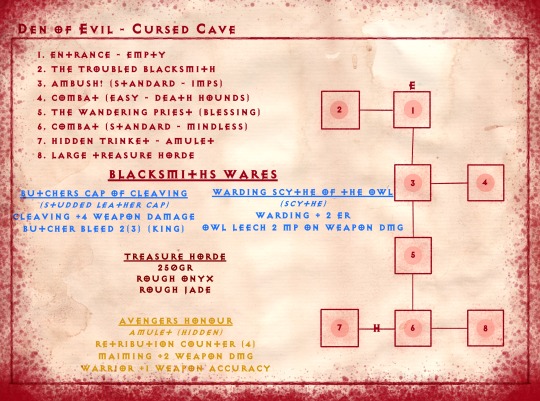
This isn't a super in depth map like you'd maybe find in D&D but it serves the purpose and feels more like a simplified Darkest Dungeon map with the corridors and random encounters there in removed and only focused on the rooms. Deciding which directions to branch from are up the GM or players if you're generating the dungeon collaboratively (Which I've also tried in test plays for a lot of fun)
No hazards were generated such as traps or environmental hazards but you can see that 2 non combat encounters were generated which have mechanical things players can interact with, 3 combat encounters where generated one being an ambush and one being an easy encounter. The book has streamlined rules for balancing encounters that's based on the spent experience of the party and party size.
Some sizable loot without needing a fight as well as a really good hidden piece of treasure were generated as well (Sadly the party didn't find the amulet it would have been a nice addition to the Faithful or Stalker most likely)

#ttrpg#ttrpgs#indie ttrpg#ttrpg design#ttrpg stuff#ttrpg community#kickstarter campaign#dungeon design
29 notes
·
View notes
Text
Building Dungeons that Tell Stories
One thing I've been hired to do a lot lately is to write a dungeon that's meant to fit into a larger adventure/product. For example, I wrote the Ivory Tower for Sarah Morris's The City Lost to Dream. I'm writing another one now, for [redacted], and I thought it'd be cool to talk through my process as I build the outline.
You can find a Notion template for my dungeon outline here! But this blog post will talk through it.
First, a disclaimer: This isn't the definitive way to make a dungeon! In fact, not all dungeons need to tell stories in this way. But the vast majority of mine do, because they're attached to one-shots, and I like the narrative completeness this style of dungeon creation affords. There's a narrative throughline to this kind of dungeon, where each room serves a purpose and allows the players to piece the story together. At the climax, the characters can use this information to make an informed decision about how to proceed.
This style is heavily inspired by the environmental storytelling found in games I've enjoyed like Bioshock and Pokemon. Every bit of the environment, down to the smallest aesthetic choice, links back to the main idea in some way. When you put all the pieces together, the image becomes clear.
So let's dive into it:
The Dungeon Thesis
The Dungeon Thesis is the story told by traversing the dungeon. What happened here? What will the party learn from each of these rooms? Every room in the dungeon should be a supporting argument for this thesis.
If you've read my adventure The Workshop Watches (get it here for free!), then you'll recognize the strong thesis there: S.A.M. is a sentient workshop who accidentally killed its creators. Every room inside S.A.M. supports this thesis, by providing more insight into Illumar's research and S.A.M.'s actions since its creation.
The Dungeon Background section can help you with this thesis. Who lives in this dungeon now? Why was it originally created? What conflict is created by the disparity in the answer between those two questions?
While your final draft probably won't have a section labeled "Dungeon Thesis," the entire thing should have echoes of what you put here in your outline throughout.
The Dungeon Gimmick
Not every dungeon needs a gimmick, but it is a great way to make this encounter stand out. Maybe the corridors shift, or the characters are running on a timer. Maybe your dungeon is sentient and very, very curious. When coming up with a dungeon gimmick, also consider the other overarching features of the dungeon. How are the halls lit (and who made it that way)? Are there doors? Do they lock?
When adding a gimmick to your dungeon, make sure you introduce it right away. I'll cover this more in the entryway section, but it's a good idea to establish the gimmick as soon as possible, and keep reinforcing it, so it sticks in the GM's mind (and therefore their players' minds). Here's the gimmick from The Workshop Watches:

Individual Rooms: Purpose, Challenge, and Reward
The meat of a dungeon is, of course, its rooms. I have a three-pronged approach to coming up with the rooms: purpose, challenge, and reward.
Purpose
Why is this room important to the overall dungeon? What can the characters learn from traversing this room that will lead them closer to the thesis? Does it establish the ruthlessness of the villain, betray a secret weakness of your enemy, or provide more context for what's going on here?
You don't always have to come up with the purpose first. Sometimes you look at your dungeon layout and say, "I need more combat." So build your combat encounter, and then retroactively determine why that's necessary to the story.
That's what I did for The Workshop Watches. I added the greenhouse fight because the dungeon needed more combat. I asked myself, "what kinds of rooms would exist in a wizard's laboratory?" and settled on a greenhouse full of magical plants. Later on, I came up with the temperature control mechanic, where S.A.M. would counter cold damage with fire damage and fire damage with cold damage. A burnt section of the greenhouse suggests that S.A.M. has incinerated something-or someone-before.
Challenge
What are the characters meant to do in this room? This one is the most straightforward, but writing it out can help you keep track of the balance between different types of challenges. Combat, exploration, social, trap diffusion, puzzle solving, etc.
Reward
What do the characters get for completing the challenge in this room? Sometimes the reward is just "passage to the next room." Sometimes it's as explicit as "treasure!" But think outside the box for things your players would appreciate inside a dungeon: new tools, the opportunity for a rest, more lore, a role play opportunity.
There can be multiple Purposes, Challenges, or Rewards in one room, but try not to overdo it! Conversely, you can cheat a little bit and have them overlap or omit one ("The purpose of this room is simply to be a place for the characters to rest -- a reward! The challenge is in whether they'll recognize it or not")
Examples
The template has more questions for special room types. I won't go through all of them, but I do want to share some examples from my outline for The City Lost To Dream. Here's the entryway example:

Later on, I realized that there wasn't enough in the entryway. The final draft has a statue of the tower's founder and clues to suggest you should rub the bottom of her robe, which grants you a boon on a check. A fun reward for a History challenge.
Another example, one of the Laboratory floors:

You can see there's multiple challenges here, but no concrete reward yet. In the final draft, the aboleth can help you in a later encounter, but it also grants you three "knowledge" wishes (basically, three castings of legend lore).
The Climax
The climax of the dungeon - the final confrontation. Most dungeon delving games consider some kind of confrontation to be a great cap to the adventure. Combat is especially popular here. Give your characters something to fight!
But almost as important as the fight is the choice. A question I am constantly asking myself is, "The Characters learned all that information you gave them; now what are they going to do about it?" This is a roleplaying game, after all! When the characters learn the full truth of the dungeon and uncover its thesis, it may change their minds about how to proceed. Maybe they must choose between two potential adversaries, or choose whether or not to fight, or choose whether or not to use lethal force.
And that's the outline! I hope it's helpful to folks who are interested in creating this style of dungeon. Definitely pick up a copy of The City Lost to Dream if you haven't already; it's a fun 5e adventure! And let me know what you think of this method.
70 notes
·
View notes
Text
Dungeon Appreciation Post #4 - Womb of Grief (Shin Megami Tensei: Strange Journey Redux)
I mean, just look at this thing. The scale of the optional extra dungeon in SMT: SJR is something I aspire to. I mean, the original game came out for Nintendo DS in 2009, the remake (and thus this dungeon) in 2017, but the design here is truly old school.
While the dungeon itself is super recent, it follows the general design of dungeons in the main game, which is to fill just about as much of the map grid as possible on each floor, except this one has seven, and you return to it, going deeper each time as you go through the main story. Typically, you go to a lower floor and eventually open a shortcut to the one above so that you can return more easily.

The Womb of Grief makes heavy use of conveyor floor tiles and teleporter tiles with unclear destinations, classic but controversial elements in DRPGs, some say outdated. Strange Journey was notable for throwing back to these designs that have in some ways fell out of fashion, but they are classic confusion tactics. My first experience with both of these was Pokemon Blue, with conveyor tiles in the Celadon Game Corner and teleporters in Sabrina's Gym. It also has some invisible floors, and pit traps that can take you to an unfamiliar part of a lower floor. It's main characteristic is that it's huge and very difficult to traverse, and is so despite having the map fill in as you go.
In a simpler game like Pokemon, similar traps present no real problem, but are a nod to the games that inspired them both, but in the Womb of Grief, though you map the dungeon out and can try paths you haven't yet tried, the complexity is cranked to such a level that you can have a hard time keeping track of where teleporters lead that you definitely have already been through, just because there are so many to keep track of. There's also a floor where teleporters have multiple destinations depending on the order you used them in. Both enemy encounters and poison and sleep tiles will drag and punish your failures of memory and mapping, which you might need to do on paper.
Takeaways for my own game: The Womb of Grief upsets players. It's beautiful. Strange Journey directly inspired my decision to make a dungeon crawler. But, I don't want my own game to feel as oppressive, necessarily, that requires trust from the players that I as an unknown will not have. However, I do love a sprawling dungeon that feels dangerous and uncharted. I'm not necessarily as interested in having a dungeon fill literally all available space to the point it loses a readable form, but mine will have verticality, so there's a ton of space to play with layout. I don't have to use traditional conveyor tiles, but what about a slide? It's already possible to fall off ledges, so why not have pitfalls and leaps of faith? I do want the spaces to feel real and take advantage of three dimensions, which is where the intertwined maps of Dark Souls (the first) might guide me. I'm considering having the bulk of the game take place in one mega-dungeon, so I'm looking for ways to add variety within it. In that sense shortcuts to different sectors as a progression mechanic will be a must.
#game design#rpg#jrpg#dungeon design#dungeons#dungeon map#video games#rpg design#shin megami tensei#strange journey#smt strange journey
9 notes
·
View notes
Text
Your perspective really changes when you start looking at dungeons as thrill rides. Like, you gotta consider the fun factor when you build it.
When an adventurer triggers a trap, they should have a reasonable window to dodge so they can properly see the rotating blades that nearly skewered them. The adventurer will feel accomplished, and you'll get to show off your cool design. The pitfall trap door should not lead to a pit of spikes, but to an iron cage that is transported into a special jail section - alternatives to instant death! Riddles too, they are often too frustrating because the solution seems intentionally obtuse. But a good dungeon riddle will let you try out a few things, figure out how all the parts connect, so that you can solve it with a good amount of effort.
And think about the room layout. Just one corridor after the next, with a room with a trap, then the next room with a trap; so monotonous. Mix it up a little! Add a roundabout where you have to overcome a set of rooms to proceed. Add a passage high up with a window looking down on previous rooms so that the party can see how far they've come. All of these design choices come together to make a dungeon experience unforgettable. If you do everything right, the party will exit the dungeon and go "Wow, that was so challenging but fun!"
A dungeon full of traps that will kill you is more of death hole, and I guess that could also cater to a certain demographic. But unless you wanna attract true freaks, you shouldn't do that. Chances are your visitors will make many unflattering comments, or vandalize the interior.
#dnd#dungeons and dragons#dungeons in particular#dungeon#worldbuilding#dungeon design#of course you need to charge entrance fees
3 notes
·
View notes
Text
Dungeon 23, Month of September, the Kobold Fortress

13 notes
·
View notes
Text
Small-ish dungeon I whipped together in a couple days for my seven-day dungeon jam.


Designed for bastards. by Micah Anderson, but everything is described in a pretty system-agnostic way, so it should be easily compatible with any old-school dungeon game.
177 notes
·
View notes
Text

My first week of #dungeon23 has gone off without a hitch, and the first floor of January's dungeon, Temple of the Vermin King, is complete! Already a lot of lessons learned, which I can't wait to channel into the next floor
33 notes
·
View notes
Text
Try these puzzle ideas for your D&D / TTRPG adventures.
#Puzzles#D&D#DnD#Dungeons and Dragons#TTRPG#Tabletop#RPGs#Roleplaying Games#Dungeon Master#Game Master#Dungeon Design
8 notes
·
View notes